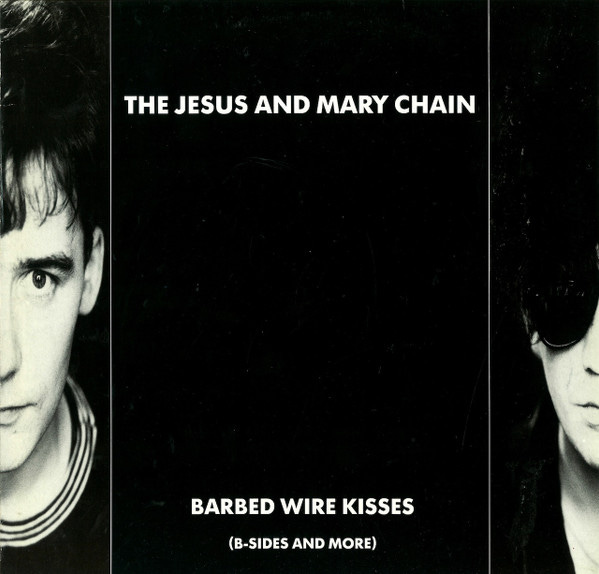The Jesus and Mary Chain: Barbed Wire Kisses, 1988
Their 1988 b-sides-and-more comp is in some ways the perfect encapsulation of the band
In the ‘80s, and into the ‘90s, a pair of trendlets felt significant in new wave/college rock.
The first, more significant one was the artist compilation serving not just an introduction to a given artist - that was often the case - but as an almost just-as-vital entry in that artist’s discography. This was particularly true when 12” versions and b-sides were included, and was thoroughly a phenomenon amongst British artists, important in an era when a lot of their global fans perhaps couldn’t afford to just plunk down for every import single by their favorites. (Remember import singles?)
Think of New Order’s Substance 1987, which did both: the “regular” album featured their singles entirely in their extended versions, and what we’d now call the deluxe edition (cassette and CD, though I doubt too many New Order fans had CD players in 1987) included a bonus record of the b-sides of those 12” singles. For many, this was the first time these b-sides were available. For many others, it may have been (it certainly was for me) the first time they heard many of the 12” extended versions. The Smiths, meanwhile, collected non-album tracks more than once: in the UK on 1984’s Hatful of Hollow (BBC sessions and a couple of a- and b-sides) and 1987’s The World Won’t Listen (largely singles and b-sides from 1985-87), and in the US with ‘87’s Louder Than Bombs (intended to replace both Hatful and World for America).
The other mini-trend was that of the b-sides compilation serving as a discrete, stand-alone album itself. You can see that in the case of the second cassette/disc of Substance 1987. It also rings true for the Cure, whose 1986 collection Standing on a Beach came, in its cassette version, with a side b of all of their non-album b-sides. As much as I loved the singles, I also found the b-sides comp more purely exciting - and still do. Within the last year, I tracked down a cassette copy, still the only place you can find these b-sides in this order (they were all subsequently included on the 2004 rarities and b-sides collection Kill the Dots), and play it with surprising frequency. (Yes, I have an old boombox on which to play my smattering of vintage cassettes.)
Filling both of these roles as well was the Jesus and Mary Chain’s Barbed Wire Kisses, released in 1988 after their first two albums, 1985’s epochal Psychocandy and its 1987 follow-up Darklands. Most of the tracks on Kisses are b-sides, alongside a smattering of unreleased songs and a pair of non-album singles, including the new “Sidewalking.” It makes for a surprisingly cohesive, albeit completely non-chronological, listening experience, covering the first four years of their recording output. “Sidewalking” was the sound of JAMC refining their approach, streamlining their sound and making it just a bit more sleek - some might even say pop-friendly? It’s also one of their best singles.
Kisses goes all the way back to their 1984 debut single, “Upside Down,” on which you can already hear much of what made JAMC special. SPIN’s Andrea ‘Enthal called their use of feedback on “Upside Down” “...a sheer blast of power that threatens to overtake the big-beat drum and wrest control of the song. It buries Jim Reid's gentle and harmonic vocals, as if he'd sung them for a braking train. … Like a synthesizer in hell, or a siren at full wail, the sound of feedback is an instrument in itself.” (I mean, I can’t say it better.)
They soak their marvelous cover of “Surfin’ U.S.A.” in feedback, too, as they do the original “Kill Surf City” (which opens the album). The demo version of “On the Wall” doesn’t feature loads of feedback, but does have a Dick Dale-esque lead guitar line; their love/hate relationship with Southern California surf culture has always fascinated me. (Also, this version of “On the Wall” always reminds me of Steven Hufsteter’s “theme” for the documentary film Z Channel: A Magnificent Obsession, which you can hear in its trailer.) But they’re not one-dimensional. Take for instance “Psycho Candy,” which, while the title of their debut, doesn’t actually appear on it, and doesn’t feature any feedback at all: it’s a tender, largely acoustic song, almost a strummy lullaby of sorts. There’s also an entirely acoustic take on Psychocandy’s “Taste of Cindy,” which reminds you that before they laid it on thick in the studio, what Jim and William Reid did first is write some really good, sometimes great, songs.
I was partially inspired to write about Barbed Wire Kisses after reading some thoughts on it by author/musician Ben Winch, who said in part, “The thing about this album, as compared to Darklands (too fey, too classic) or Psychocandy (too smothered in dirt) is it’s got some of everything – every trick, technique or mood they’d used by then… .” And the thing is, he’s absolutely right. This approach, encompassing multiple years, serves JAMC impeccably. Kisses shows off everything they did well, in one tidy package. And frankly, the way it zigs and zags with abandon works great, too. Obviously, the band’s first two albums are great, in different ways. But when I want to hear the greatness of the Jesus and Mary Chain in one complete package - and to be honest, after this (with exceptions, of course), their catalog is one of increasingly diminishing returns - Barbed Wire Kisses is exactly what I want.
[Originally written for Rock and Roll Globe in 2023.]



